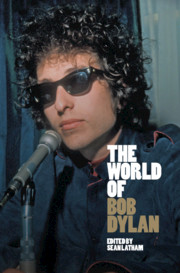Book contents
- The World of Bob Dylan
- The World of Bob Dylan
- Copyright page
- Contents
- Contributors
- Acknowledgments
- Introduction: Time to Say Goodbye Again
- Part I Creative Life
- Part II Musical Contexts
- Part III Cultural Contexts
- Chapter 12 American Literature
- Chapter 13 World Literature
- Chapter 14 The Beats
- Chapter 15 Theatre
- Chapter 16 Visual Arts: Goya’s Kiss
- Chapter 17 Borrowing
- Chapter 18 Judaism: Saturnine Melancholy and Dylan’s Jewish Gnosis
- Chapter 19 Christianity: An Exegesis of Modern Times
- Part IV Political Contexts
- Part V Reception and Legacy
- Further Reading
- Index
Chapter 14 - The Beats
from Part III - Cultural Contexts
Published online by Cambridge University Press: 21 April 2021
- The World of Bob Dylan
- The World of Bob Dylan
- Copyright page
- Contents
- Contributors
- Acknowledgments
- Introduction: Time to Say Goodbye Again
- Part I Creative Life
- Part II Musical Contexts
- Part III Cultural Contexts
- Chapter 12 American Literature
- Chapter 13 World Literature
- Chapter 14 The Beats
- Chapter 15 Theatre
- Chapter 16 Visual Arts: Goya’s Kiss
- Chapter 17 Borrowing
- Chapter 18 Judaism: Saturnine Melancholy and Dylan’s Jewish Gnosis
- Chapter 19 Christianity: An Exegesis of Modern Times
- Part IV Political Contexts
- Part V Reception and Legacy
- Further Reading
- Index
Summary
In 1983, pioneering scholar Ann Charters oversaw the publication of The Beats: Literary Bohemians in Postwar America, a two-volume collection of entries on more than sixty figures associated with the movement. Released roughly a quarter century after groundbreaking work like Allen Ginsberg’s Howl and Other Poems (1956) and Jack Kerouac’s On the Road (1957), this project staked a claim for the ongoing relevance of the Beats by presenting them not as a small clique of writer-friends, but as a more far-reaching literary movement and cultural phenomenon. In the spirit of such capaciousness, Charters brought Bob Dylan into the Beat fold, and contributing scholar Joseph Wenke argued that the songwriter merited inclusion because he shared Beat “attitudes toward social authority, politics, and drugs, emphasizing the primacy of the self and rejecting institutionally prescribed norms. … the style of Dylan’s most characteristic lyrics unmistakably reveals that Beat poetry was a strong influence on him as he developed into the most provocative and imaginative lyricist of his generation.”1 This two-pronged notion, that Dylan shared both social “attitudes” with the Beats and that his work bears the marks of their formal techniques and thematic preoccupations, has been a starting point for those who have thought about him in a Beat context.2
- Type
- Chapter
- Information
- The World of Bob Dylan , pp. 169 - 180Publisher: Cambridge University PressPrint publication year: 2021
- 1
- Cited by

